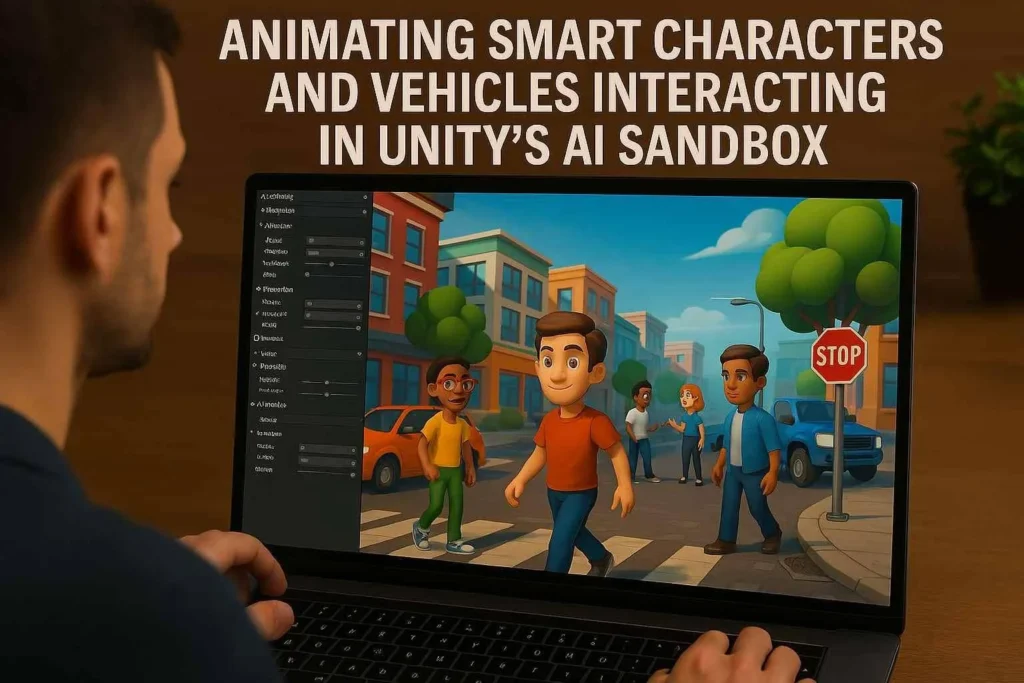In the rapidly evolving landscape of video game development, the quest to create more lifelike and intelligent virtual entities has never been more fervent. Game developers are constantly pushing the boundaries of what AI can achieve, transforming simple 3D models into fully sentient, interactive characters and vehicles. Leveraging Unity’s robust AI capabilities, developers are crafting experiences that are not only visually stunning but also intellectually engaging. This article delves into the intricacies of AI character design, smart game AI, and the dynamic interplay of 3D character and vehicle animations in Unity.
The Evolution of AI in Gaming
The journey from basic programmed responses to sophisticated, AI-driven interactions is a testament to the advancements in game AI development. Historically, game AI was limited to scripted behaviors, offering predictable and often repetitive interactions. However, as technology has advanced, so too has the complexity of AI systems, which are now capable of learning, adapting, and providing unique, player-driven experiences.
From Scripted to Adaptive AI
Initially, game AI was built upon simple scripts that dictated specific responses to player actions. These scripts were limited in scope and lacked flexibility, often resulting in predictable gameplay. However, as developers sought to create more engaging experiences, adaptive AI systems emerged. These systems utilize algorithms that allow characters to learn from their interactions with players, adapting their behavior in real-time.
Incorporating Machine Learning
Machine learning has revolutionized the way AI is integrated into gaming. By employing machine learning techniques, developers can create AI models that evolve based on player interactions. This not only enhances the realism of AI behavior but also increases the replay value of games, as characters can offer new challenges and experiences with each playthrough. Unity’s ML-Agents toolkit has been instrumental in facilitating this integration, providing developers with the resources to train AI models efficiently.
The Role of Neural Networks
Neural networks play a critical role in the development of advanced game AI. These networks mimic the structure of the human brain, allowing AI characters to process vast amounts of data and make complex decisions. By leveraging neural networks, developers can create AI entities that exhibit human-like reasoning and problem-solving abilities. This advancement has paved the way for more immersive and unpredictable gaming experiences, where AI characters can respond to players in dynamic and nuanced ways.
The Rise of Smart Characters
Smart characters are at the forefront of this evolution. They are designed to perceive their environment, make decisions, and interact with players in a manner that mimics human behavior. Unity’s AI tools have been pivotal in this transformation, providing developers with the resources to create characters that are not only reactive but also proactive in their engagement with the game world.
Environmental Awareness
Smart characters are equipped with the ability to perceive and interpret their surroundings. This environmental awareness is achieved through sensors and algorithms that process visual and auditory information. By understanding the game world, these characters can navigate complex terrains, avoid obstacles, and interact with other entities in a realistic manner. This level of awareness enhances the player’s immersion, as characters respond intelligently to changes in their environment.
Decision-Making Algorithms
The decision-making process of smart characters is driven by sophisticated algorithms that weigh various factors before determining a course of action. These algorithms consider player inputs, environmental conditions, and the character’s goals to make informed decisions. By simulating human-like reasoning, smart characters can engage players in meaningful interactions, offering challenges and experiences that are both engaging and unpredictable.
Proactive Engagement
Unlike traditional AI that reacts to player actions, smart characters are designed to be proactive in their interactions. They can initiate dialogues, offer assistance, or even challenge players, creating a dynamic and interactive gaming experience. This proactive engagement is made possible by AI models that allow characters to anticipate player needs and respond accordingly, fostering a deeper connection between the player and the game world.
AI Character Design in Unity
The process of designing AI characters within the Unity game development environment involves a careful and detailed approach that requires multiple stages, including modeling, animating, and programming the characters. Initially, developers engage with 3D character designers who are tasked with creating highly detailed character models. These models act as the essential building blocks for integrating AI functionality into the game. Once the character models are completed, they undergo a rigorous animation process where developers ensure that the movements of the characters are fluid and realistic, mimicking natural actions to enhance the overall gaming experience. This step is crucial, as well-animated characters contribute significantly to player immersion and engagement in the game world.
Detailed 3D Modeling
The foundation of AI character design lies in the creation of detailed 3D models. Artists use advanced modeling software to sculpt characters with realistic features and proportions. These models serve as the visual representation of AI entities, and their quality directly impacts the player’s immersion. By focusing on intricate details, developers can create characters that are visually appealing and lifelike.
Realistic Animation Techniques
Animation is a crucial aspect of AI character design, as it brings models to life. Developers employ a variety of techniques to ensure smooth and believable movements. Motion capture technology is often used to record the actions of real actors, which are then applied to 3D models. This technique captures the nuances of human motion, resulting in animations that are both fluid and realistic. Additionally, procedural animation techniques allow characters to adapt their movements dynamically, further enhancing their realism.
Programming AI Behaviors
Once the physical attributes are established, the AI development phase begins. Unity’s NavMesh and Machine Learning Agents (ML-Agents) are instrumental in this process, allowing characters to navigate complex environments and learn from player interactions. Developers program behaviors that dictate how characters respond to various stimuli, ensuring they act in accordance with the game’s narrative and mechanics. This results in a dynamic gaming experience where characters can adapt to various scenarios, enhancing the overall immersion.
Vehicles in the AI Equation
While characters often steal the spotlight, vehicles play a crucial role in creating an immersive gaming experience. The integration of AI into 3D automotive modeling has opened new avenues for interaction and realism. Smart vehicles in games are no longer mere objects but active participants in the narrative.
Advanced 3D Automotive Modeling
The process of 3D automotive modeling involves creating vehicles that are not only visually appealing but also functionally accurate. Designers focus on replicating the intricate details of real-world vehicles, from the bodywork to the interior components. This attention to detail ensures that vehicles look and feel authentic, providing players with a realistic driving experience. The accuracy of these models is further enhanced by the use of high-resolution textures and advanced rendering techniques.
AI-Driven Vehicle Interactions
AI integration ensures these vehicles can interact with their environment and respond to player inputs in a realistic manner. Unity’s physics engine, combined with AI programming, allows for the creation of vehicles that can navigate terrain, avoid obstacles, and even engage in strategic maneuvers. By simulating real-world physics, developers create a driving experience that is both challenging and rewarding. Players must adapt their driving style to the conditions of the game world, enhancing the overall immersion.
Strategic Vehicle Gameplay
The implementation of AI in vehicles adds a strategic layer to gameplay. Players must consider factors such as vehicle capabilities, environmental conditions, and AI-driven opponents when making decisions. This strategic element encourages players to think critically and adapt their approach, resulting in a more engaging and dynamic gaming experience. The interplay between AI-driven characters and vehicles creates opportunities for collaborative tasks, high-speed chases, and intense battles, elevating the overall excitement of the game.
The Role of AI in Game Narratives
AI doesn’t just enhance gameplay mechanics; it also enriches game narratives. By enabling characters and vehicles to exhibit lifelike behaviors, AI contributes to the storytelling aspect of games. Players become more invested in the narrative when they perceive characters as sentient beings with distinct personalities and motivations.
Dynamic Narrative Experiences
Game developers and writers collaborate to create storylines that leverage AI capabilities. Characters can be designed to remember player choices, react to them, and evolve over time. This creates a personalized narrative experience that can differ with each playthrough, encouraging replayability and deeper engagement. By allowing players to influence the story, developers create a sense of agency and investment that enhances the overall gaming experience.
Character Development and Backstories
AI-driven characters often come with rich backstories and personalities that influence their behavior and interactions. Developers craft detailed character profiles that dictate how AI entities respond to player actions and the game world. This depth of character development adds layers to the narrative, as players uncover motivations, alliances, and conflicts. By intertwining character arcs with the main storyline, developers create a cohesive and immersive narrative experience.
Player-Driven Storytelling
AI enables a level of player-driven storytelling that was previously unattainable. As players interact with AI characters and vehicles, they influence the direction of the narrative. This interactivity allows for multiple story paths and endings, each shaped by the player’s decisions. By empowering players to craft their own stories, developers foster a deeper connection between the player and the game world, resulting in a more memorable and impactful experience.
Challenges and Future Directions
While the advancements in AI character and vehicle design are impressive, developers face several challenges. Balancing realism with performance, ensuring consistent AI behavior across various platforms, and maintaining player interest are ongoing concerns.
Technical and Performance Challenges
The complexity of AI systems requires robust testing and optimization. Developers must strike a balance between AI sophistication and computational efficiency to ensure smooth gameplay. High-quality AI models demand significant processing power, which can impact performance on lower-end devices. To address these challenges, developers utilize optimization techniques such as level of detail (LOD) and adaptive algorithms to maintain a seamless experience across platforms.
Ensuring Consistency Across Platforms
As gaming extends across multiple platforms, ensuring consistent AI behavior is crucial. Developers must account for differences in hardware capabilities, input methods, and performance constraints. Cross-platform development tools and rigorous testing help maintain a consistent experience, ensuring players receive the same level of AI sophistication regardless of their device. Unity’s platform-agnostic engine facilitates this process, allowing developers to optimize AI models for a wide range of systems.
Innovations on the Horizon
The future of AI in gaming holds immense potential. As machine learning and AI technologies advance, we can expect even more intelligent and adaptive game entities. The integration of virtual reality (VR) and augmented reality (AR) with AI will further blur the lines between virtual and real-world experiences, offering players unprecedented levels of immersion. Developers are exploring the use of AI to create procedurally generated content, adaptive narratives, and personalized gaming experiences, promising a future where games are not just played but lived.
Conclusion
The journey from simple models to sentient characters and vehicles is a testament to the power of AI in gaming. Unity’s AI capabilities have empowered developers to create dynamic, engaging, and lifelike game experiences. As technology continues to evolve, the possibilities for AI-driven characters and vehicles are limitless, promising a future where games are not just played but lived.
In this ever-evolving industry, staying informed and adaptable is crucial. By embracing the potential of AI and continuing to push the boundaries of what’s possible, game developers can create unforgettable gaming experiences that captivate and inspire players worldwide. As AI continues to advance, the line between virtual and reality will continue to blur, offering players new and exciting ways to engage with digital worlds.


